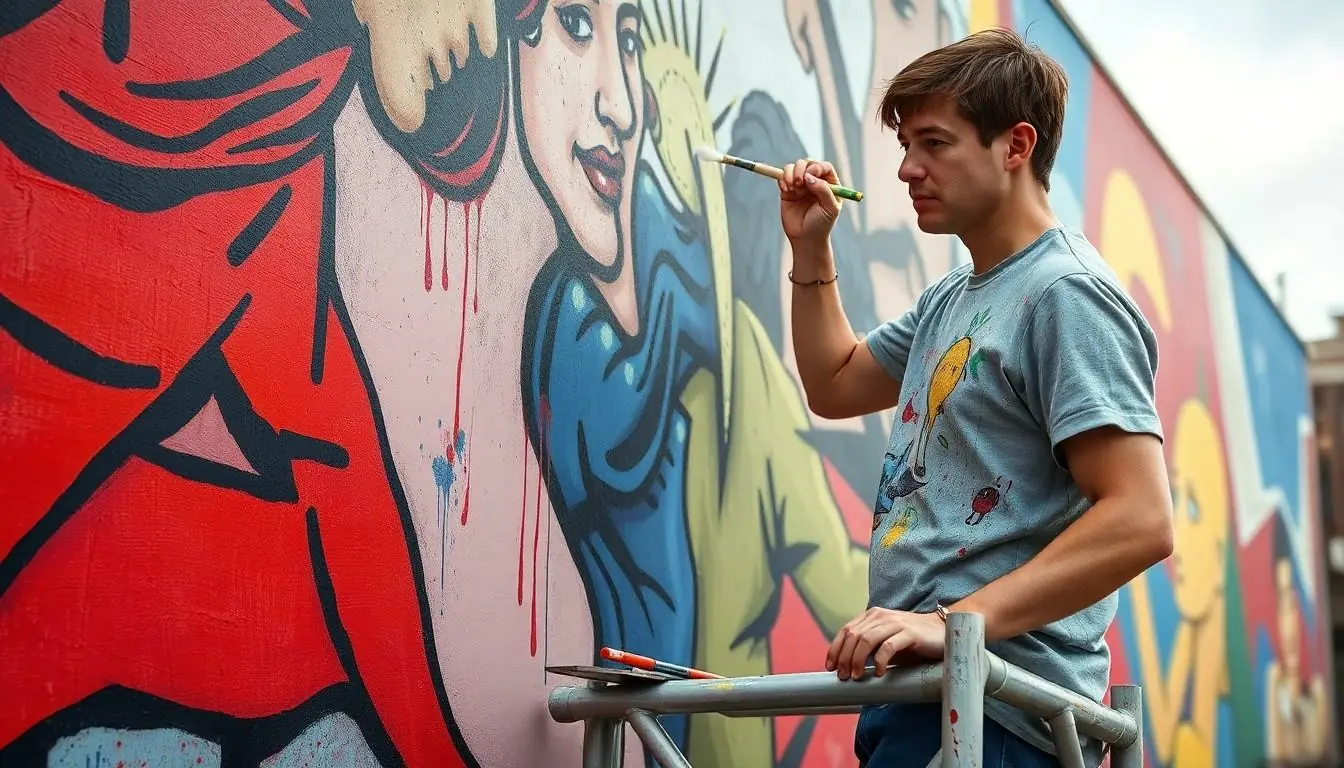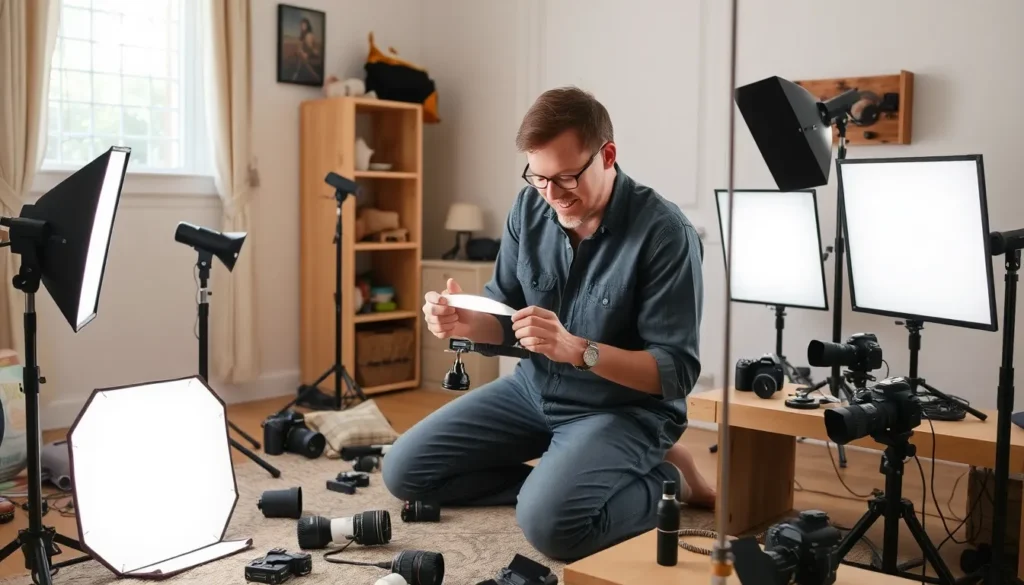Fresco painting isn’t just a fancy term for slapping paint on a wall; it’s an ancient art form that’s been turning heads for centuries. Imagine vibrant colors and stunning scenes that seem to leap off the surface, all created while the plaster is still wet. Talk about a race against time! This technique has graced the walls of cathedrals, palaces, and even the odd bathroom, proving that art can truly be everywhere.
Table of Contents
ToggleWhat Is Fresco Painting?
Fresco painting is a classical art technique that involves applying water-based pigments to freshly laid wet plaster. This unique method allows the paint to bond with the plaster as it dries, creating a durable and vibrant surface. Artists frequently used this technique during the Renaissance to depict religious and mythological themes.
The process begins by preparing a rough layer of plaster called arriccio. Once this layer cures, artists apply a finer layer, known as intonaco. While the intonaco remains wet, they’ll paint the desired image or scene. The speed of the application is crucial, as any delay could ruin the artwork.
Frescoes are distinguishable from other painting styles due to their luminosity. Light interacts with the pigments embedded in the plaster, creating depth and vibrancy. This quality makes frescoes suitable for large-scale murals found in cathedrals and palaces.
Materials for fresco painting include natural pigments, which are often derived from minerals or plants. Common colors like ochre, vermilion, and ultramarine add rich tones to artworks. The choice of colors not only influences aesthetics but also reflects the cultural significance of the time.
Well-known examples of fresco painting include Michelangelo’s Sistine Chapel ceiling and Giotto’s Scrovegni Chapel. These masterpieces demonstrate the technique’s potential to convey emotion and narrative through color and composition.
Throughout history, fresco painting has maintained its relevance. Contemporary artists often adopt this ancient approach in modern settings, from private homes to public walls. The technique’s enduring appeal lies in its ability to create captivating and immersive visual experiences.
History Of Fresco Painting

Fresco painting has deep historical roots that trace back to ancient cultures across various regions.
Origins In Ancient Civilizations
Frescoes first emerged in ancient civilizations like Egypt, Greece, and Mesoamerica. They used this technique to depict significant events, religious practices, and daily life. In Egypt, artisans painted vibrant images on the walls of tombs, ensuring the deceased’s journey into the afterlife. The Greeks followed suit, showcasing stories from mythology on the walls of temples and public buildings. Mesoamerican cultures also practiced fresco painting, often illustrating their gods and rituals in elaborate murals. These initial expressions of fresco painting laid the groundwork for its evolution through time.
Renaissance Revival
The Renaissance marked a significant revival of fresco painting, reintroducing classical techniques and themes. Artists like Michelangelo and Raphael elevated frescoes to new heights during this period. They emphasized human emotion and detail in their works, often depicting biblical narratives and mythological scenes on large-scale ceilings and walls. Institutions, churches, and palaces became vibrant with their murals, attracting admiration from viewers. The revival catalyzed interest in naturalism, perspective, and color, establishing fresco painting as a central artistic form. This transformed the cultural landscape of Europe, making frescoes synonymous with artistic achievement and grandeur.
Techniques Used In Fresco Painting
Fresco painting employs specific techniques that contribute to its enduring appeal and distinctive qualities. The main methods include buon fresco and fresco secco.
Buon Fresco Versus Fresco Secco
Buon fresco, or true fresco, requires the application of water-based pigments onto wet plaster. This technique allows the paint to bond with the plaster as it dries, creating vibrant and durable images. Fresco secco, on the other hand, involves painting on dry plaster. While it offers more flexibility in detail, the colors can fade over time due to less adhesion. Artists often choose buon fresco for large murals, where longevity and luminosity are essential.
Tools And Materials
Specific tools and materials enhance the fresco painting process. Painters use trowels to apply layers of plaster, ensuring a smooth surface. Brushes designed for precision facilitate the application of pigments on wet plaster. Natural pigments, sourced from minerals or plants, contribute to the intense hues found in frescoes. Additionally, scaffolding supports artists while they work on expansive wall sections. Each tool and material plays a significant role, impacting the overall effectiveness and quality of the final artwork.
Famous Fresco Works
Numerous iconic fresco works stand as testaments to the artistry and historical significance of this technique.
Michelangelo’s Sistine Chapel
Michelangelo’s masterpiece spans the ceiling of the Sistine Chapel in Vatican City, completed between 1508 and 1512. This remarkable work illustrates scenes from the Book of Genesis, showcasing the Creation of Adam as a focal point. Chiaroscuro enhances the three-dimensional effect and depth of figures, skillfully breathing life into the narrative. The vibrant colors remain striking, thanks to the buon fresco technique that allows pigments to meld with the plaster. Art history recognizes this fresco for its emotional intensity and monumental scale, which profoundly influenced Western art.
Raphael’s Stanze di Raffaello
Raphael’s Stanze di Raffaello consists of frescoes painted between 1508 and 1524, located in the Vatican’s Raphael Rooms. Each room features distinct themes, with the School of Athens being particularly notable. This fresco depicts renowned philosophers and thinkers of antiquity, skillfully arranged in a grand architectural setting. Raphael’s masterful use of perspective and harmonious composition draws the viewer into a rich dialogue of knowledge and culture. This work exemplifies the Renaissance ideals of beauty and intellectual exploration, solidifying Raphael’s place in art history.
The Importance Of Fresco Painting Today
Fresco painting maintains significant relevance in contemporary art and architecture. Artists continue to draw inspiration from its rich history, adapting traditional techniques to modern themes. Various communities appreciate frescoes for their vibrant colors and emotional depth.
In urban spaces, murals created using the fresco technique enrich public art installations. These artworks foster community engagement and cultural expression. Frescoes often capture local narratives, making art accessible to a broader audience.
Art institutions and museums invest in preserving historical frescoes, recognizing their cultural value. Restoration projects showcase ancient techniques while ensuring the longevity of these masterpieces. Educational programs often include fresco painting workshops, connecting new generations with this historic art form.
Museum exhibitions frequently highlight both classic and contemporary fresco artists, demonstrating the technique’s versatility. These displays encourage dialogue about artistry and historical context. Significant fresco works, like those found in religious buildings or public spaces, serve as focal points for cultural tourism.
Architects often incorporate fresco painting into modern designs, merging classical aesthetics with contemporary functionality. This integration creates harmonious environments that reflect artistic heritage while serving practical purposes. The freshness of this ancient technique captivates audiences, contributing to the ongoing appreciation of fresco painting.
Innovative artists embrace fresco painting’s enduring nature, blending it with modern materials and themes. As a result, new artworks emerge that challenge traditional boundaries, making the technique relevant in today’s art scene. Society continues to recognize fresco painting not only as a historical practice but also as a dynamic and evolving form of creative expression.
Fresco painting stands as a testament to the enduring power of art across cultures and eras. Its unique technique marries vibrant pigments with plaster, creating works that resonate with historical significance and emotional depth. As artists continue to explore and adapt this ancient method, fresco painting remains a vital form of expression in both public and private spaces. The fusion of traditional techniques with contemporary themes ensures that this art form not only preserves its rich legacy but also evolves to reflect modern sensibilities. The appreciation for frescoes continues to grow, highlighting their role in connecting past and present through the universal language of art.



